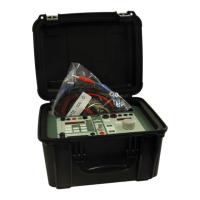PTE-100-C
31
To read the voltage applied to the load while you are injecting current, do
the following:
1) Toggle to Func. mode using the button and press
as necessary to navigate to Vtap.
2) Connect the load to an appropriate current tap and flag this tap
using the button, if not yet done. Check that the variac is
in its minimum (“0”) position now.
3) Press the button to activate the output and turn the variac
gently clockwise to regulate the current injection to the desired val-
ue on the Display #2. The applied voltage will be shown at Display
#1 simultaneously.
To measure the impedance of the connected load, follow the same steps as
above but use the |Z|tap this time. The connected impedance’s modulus
will be shown in Display #1. For greater accuracy, this measurement can
be done following the 4-wire method using the secondary mode of the
|Z|tap function:
1) Connect both sides of the connected load in parallel to the
BLACK/RED monitor inputs.
2) While you are placed at the |Z| tap function, press the
key and hold it down until a beep is heard and the function’s LED
starts blinking. You are now using the secondary measurement
mode. In this mode, the measurement is performed using the value
of the injected current and the voltage drop measured at the con-
nected load.
Impedance measurement requires a minimum amount of current (at least 10
per cent of the selected tap’s range) to be injected to the load. Non-linear
loads, i.e. those that exhibit impedance changes with time because of large
reactive components, cannot be accurately measured with this function.
Protecting your relay against test-related accidents
I lim and T lim functions automatically disconnect the output when the in-
jected current or the ON time exceed a pre-established limit respectively.
Function
USER’S MANUAL
32
You enter a current and/or time limit into Display #1 while placed in the
appropriate function using the and buttons and then acti-
vate/deactivate the protection with the button. These functions are
primarily provided as a means to protect sensitive devices against accidental
overheating.
The output will be cut off when the applied current exceeds the specified limit
by a 10 per cent. While the Tlim protection applies to the time for which the
output is ON, The Ilim protection works only with the current taps, not with the
voltage taps Out1 or Out2.
Testing Instantaneous Overcurrent
Instantaneous elements trip usually before the PTE-100-C’s digital ammeter
stabilizes itself on the Display #2, thus being impossible to know the real
current value that has caused the relay to operate.
Furthermore, some instantaneous protections are set to such a high current
value that it might damage the relay if sustained during the time that it usu-
ally takes to regulate with a reasonable accuracy.
If you meet any or both of these situations when testing instantaneous over-
current relays, use the I max, I lim and T lim functions as follows:
1) Check first that the unit’s output is deactivated and the variac is
placed at its minimum “0” position.
2) Connect the current input from the relay to the current output tap
that best accommodates the intended injection values. Flag the se-
lected output by means of the button. Connect also now
the relay’s trip contact to the PTE-100-C’s black/green monitor in-
puts, so that the unit can detect the relay’s operation and stop the
test appropriately. Refer to the Timer control section above for de-
tails on how to setup the various timer start/stop modes.
3) Place yourself at the Imax function and activate it by pressing
briefly. Its LED indicator will toggle from slow to fast blink-
ing. In the Imax mode, the PTE-100-C’s ammeter works upwards
only, i.e., it shows the maximum injected current since the last time
Enter/Print
Tap
Enter/Print

